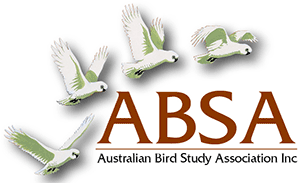MORPHOLOGY, MOULT AND SURVIVAL IN THREE SYMPATRIC BOWERBIRDS IN AUSTRALIAN WET TROPICS UPLAND RAINFOREST
| Posted: |
21/07/2021 |
| Author(s): |
Clifford B. Frith, Dawn W. Frith |
Spotted Catbirds
Ailuroedus melanotis, Tooth-billed Bowerbirds
Scenopoeetes dentirostris and Golden
Bowerbirds
Prionodura newtoniana were individually marked, measured and examined for moult in upland tropical
rainforest on the Paluma Range, northern Queensland. Their adult measurements were compared with those of
museum specimens. Biometrical data presented provide information on variation in size and weights for each
sex and age group in all three species. Adult female Spotted Catbirds and Tooth-billed Bowerbirds had shorter
wings and tails than adult males and adult female Spotted Catbirds also had smaller bills than adult males.
Golden Bowerbirds were distinctive in that females were the larger-billed sex but had a tail only 81 per cent as
long as that of adult males. Bowerbirds lost weight in September-October, at the beginning of their display and
breeding season, but gained weight as the season progressed. The overall moult period for all three species
was December to March inclusive, the peak moulting months being January to March after display and breeding
declined and wet season rains had commenced. Moult of head and body plumage began before that of wing
and tail. Immature male Golden Bowerbirds without traditional bowers began moult during September and
November, whereas adult bower-owning males began moulting in late December. Primary moult was most evident
during January and March and finished, or nearly did so, by April. It started in the mid-wing, with the innermost
primary, progressing outwards from the body in both wings simultaneously. Secondary moult was most evident
during February and March and generally began when the first four or five new primaries were fully-grown or
nearly so. It began at S1 to progress toward the body and simultaneously at S7 away from the body. The central
secondaries (S3/4-6) were thus replaced last. Tail moult usually started during early stages of primary moult,
beginning with the central pair and progressing outwards. It was finished before primary moult and was most
evident during February and March. T he timing of annual moult relative to other aspects of the life histories of
these bowerbirds is discussed. Estimated mean annual survival rate and expectancy of further life after banding
was respectively: 72 per cent and 3 years for Spotted Catbirds (both sexes); 90 per cent and 9.4 years for
Tooth-billed Bowerbirds (males only) and 91 per cent and 10.9 years for Golden Bowerbirds (males only). The
oldest Spotted Catbird we recorded was aged 19 years and a Tooth-billed and Golden Bowerbird attained 20
and 21 years respectively. Both monogamous (Spotted Catbirds) and polygynous (Tooth-billed and Golden)
bowerbirds proved to be remarkably long-lived, their high survival rates being briefly discussed in the context of
the southern hemisphere and Australian passerine avifaunas.
>> Download Abstract |
File Size: 192 KB
>> Download Complete PDF | File Size: 2 MB
